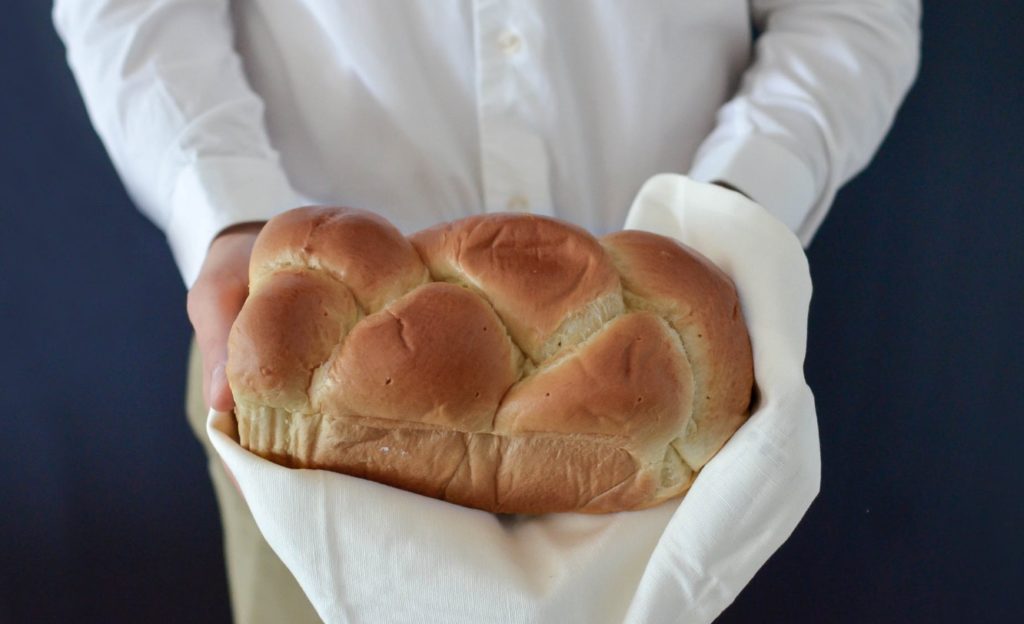HOMEMADE BRIOCHE RECIPE is a bread of French origin that is similar to a highly enriched pastry, and whose high egg and butter content (400 grams for each kilogram of flour) gives it a rich and tender crumb.
Chef Joël Robuchon describes it as “light and slightly puffy, more or less fine, according to the proportion of butter and eggs.” It has a dark, golden, and flaky crust, frequently accentuated by an egg wash applied after proofing.
Brioche is considered a Viennoiserie, in that it is made in the same basic way as bread, but has the richer aspect of a pastry because of the extra addition of eggs, butter, liquid (milk, water, cream, and, sometimes, brandy) and occasionally some sugar.
PIN FOR LATER:
[pinterest-image message=”JUDY’S HOMEMADE BRIOCHE RECIPE #brioche #bread #recipe #food #easylife” align=”center” image=”https://01easylife.com/wp-content/uploads/2019/08/judy-brioche.png”]
Ingredients:
- 6 eggs (at room temperature)
- 1 cup unsalted butter (2 sticks/½ pound/230g, at room temperature)
- 4 ¾ cups all-purpose flour (620g, divided)
To Find Out All The Yummy Ingredients And The Step By Step Directions To Follow for this Delicious recipe, Please Open The Next Page.
Brioche, along with pain au lait and pain aux raisins which are commonly eaten at breakfast or as a snack—form a leavened subgroup of Viennoiserie.
Brioche is often cooked with fruit or chocolate chips and served on its own or as the basis of a dessert with many local variations in added ingredients, fillings or toppings.
Ingredients:
- 6 eggs (at room temperature)
- 1 cup unsalted butter (2 sticks/½ pound/230g, at room temperature)
- 4 ¾ cups all-purpose flour (620g, divided)
- 1 tablespoon active dry yeast (9g)
- ¼ cup granulated sugar (50g)
- 1½ teaspoons salt (8g)
- ½ cup warm water (120 ml, about 120 degrees F/49 degrees C)
- 2 teaspoons sugar (10g, dissolved in 1 tablespoon/15 ml water)
To Find Out Step By Step Directions To Follow for this Delicious recipe, Open the next page.
Instructions:
Day 1:
- Take out 6 eggs and 1 cup / 230g butter a few hours before you begin to bring them to room temperature. Prepare all other ingredients before starting.
- In the bowl of an electric mixer fitted with a paddle attachment, mix together 1 cup flour (130g), 1 tablespoon active dry yeast (9g), ¼ cup granulated sugar (50g), and 1½ teaspoons salt (8g), before adding ½ cup (120 ml) warm water (at about 120 degrees F/49 degrees C). Turn the mixer on at medium speed for a couple of minutes until well-combined.
- Now add in 1 egg at a time. Only add the next egg when the previous egg is well incorporated.
- Set the mixer to low. Add in 2 cups of flour (260g), a ¼ cup at a time, and let the mixer go until the dough is well combined.
- Turn the mixer off, and cut the 2 sticks of softened butter into small cubes/chunks. With the mixer on medium, add the butter in 6 separate batches, waiting until the butter is well incorporated after each batch before adding more.
- Set mixer to low. Now add in 1 3/4 cups of flour (230 grams), a ¼ cup at a time until the dough is well-combined. This dough will be very sticky (closer to a very thick batter) when it’s done.
- Use a rubber spatula to clean the dough off the mixing paddle, and scrape the sides of the mixing bowl. Cover the dough with a plate or plastic wrap and let it proof at room temperature (about 70 degrees F/21 degrees C) for 3 hours, until it doubles in size.
- After 3 hours have elapsed, punch and deflate the dough completely with a rubber spatula. Cover the dough with a plate again, and refrigerate it overnight until 3 hours before you’re ready to bake the next day.
Day 2:
- Remove the dough from the refrigerator. Divide it into two equal pieces. Shape them on a lightly floured clean surface, and place each into its own loaf pan. The chilled dough is a bit stiffer to work with, so you can use a rolling pin to help shape it into the desired width and length. If you do this, make sure to roll the dough lengthwise like a cigar when you’re done to ensure a rounded top to your loaf. Whatever you do, the dough should fit snugly in the loaf pan.
- Now, you can create plain loaves as I’ve described above, or you could create a braid or individual buns, as pictured. Totally up to you, the baker!
- Cover each loaf pan tightly with clear plastic wrap, and let proof at room temperature for about 2½ to 3 hours, until doubled in size.
- Preheat the oven to 350 degrees F / 180 degrees C while the dough is proofing. Bake for 37 to 40 minutes in the center of the oven. Tent the loaves with foil if the crust is getting too dark. While it’s baking, prepare the sugar water by mixing 2 teaspoons sugar with 1 tablespoon water until the sugar is completely dissolved. When bread is done, remove from the oven, and immediately brush the tops of the bread with sugar water to give it that shiny finish.
- Let the bread sit in the loaf pan for 5 minutes to cool before transferring the loaves from the pans to a cooling rack. This cooling step is important so the bread does not fall apart.
- Once the bread has cooled completely, you can store it in a tightly sealed container or zip-lock bag to keep it fresh. This bread is also heavenly when served slightly warm with softened butter.
From: wikipedia
